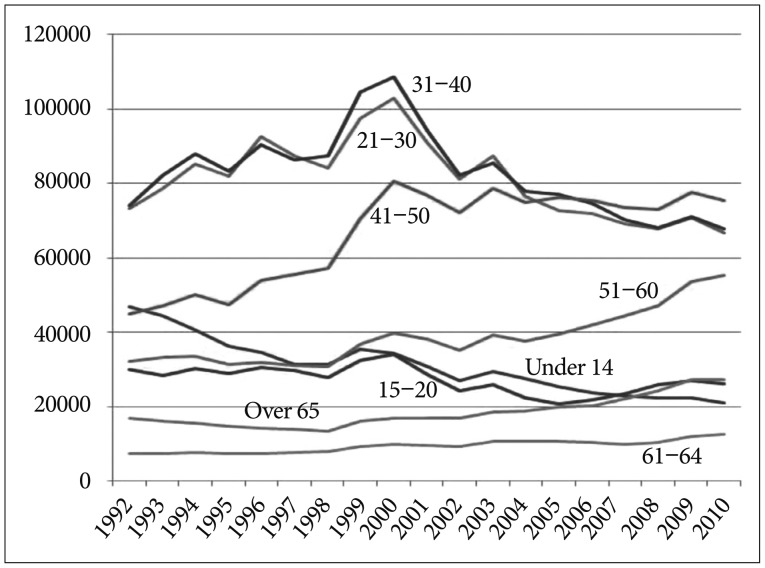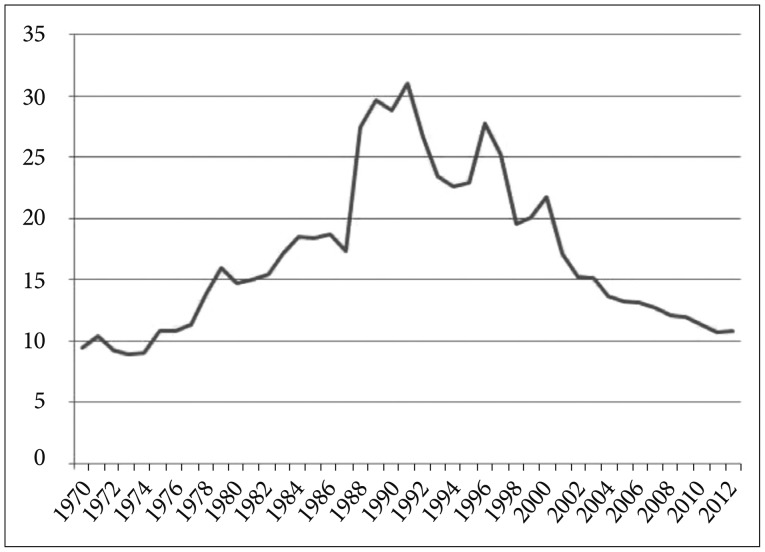J Korean Neurosurg Soc.
2016 Mar;59(2):149-153. 10.3340/jkns.2016.59.2.149.
Epidemiologic Impact of Rapid Industrialization on Head Injury Based on Traffic Accident Statistics in Korea
- Affiliations
-
- 1Deaprtment of Neurosurgery, Chungbuk National University Hospital, Cheongju, Korea. dhkim@chungbuk.ac.kr
- 2Department of Neurosurgery, Jeju National University Hospital, Jeju, Korea.
- KMID: 2192045
- DOI: http://doi.org/10.3340/jkns.2016.59.2.149
Abstract
OBJECTIVE
The aim of the present study is to estimate the incidence trend of head injury and the mortality based on traffic accident statistics and to investigate the impacts of rapid industrialization and economic growth on epidemiology of head injury in Korea over the period 1970-2012 including both pre-industrialized and post-industrialized stages.
METHODS
We collected data of head injury estimated from traffic accident statistics and seven hospital based reports to see incidence trends between 1970 and 2012. We also investigated the population structure and Gross National Income (GNI) per capita of Korea over the same period. The age specific data were investigated from 1992 to 2012.
RESULTS
The incidence of head injury gradually rose in the 1970s and the 1980s but stabilized until the 1990s with transient rise and then started to decline slowly in the 2000s. The mortality grew until 1991 but gradually declined ever since. However, the old age groups showed rather slight increase in both rates. The degree of decrease in the mortality has been more rapid than the incidence on head injury.
CONCLUSION
In Korea during the low income stage, rapid industrialization cause considerable increase in the mortality and the incidence of head injury. During the high income stage, the incidence of head injury gradually declined and the mortality dropped more rapidly than the incidence due to preventive measures and satisfactory medical care. Nevertheless, the old age groups revealed rather slight increase in both rates owing to the large population structure and the declining birth rate.
Keyword
MeSH Terms
Figure
Reference
-
1. Andersson EH, Björklund R, Emanuelson I, Stålhammar D. Epidemiology of traumatic brain injury : a population based study in western Sweden. Acta Neurol Scand. 2003; 107:256–259. PMID: 12675698.
Article2. Bachulis BL, Sangster W, Gorrell GW, Long WB. Patterns of injury in helmeted and nonhelmeted motorcyclists. Am J Surg. 1988; 155:708–711. PMID: 3369630.
Article3. Bruns J Jr, Hauser WA. The epidemiology of traumatic brain injury : a review. Epilepsia. 2003; 44(Suppl 10):2–10. PMID: 14511388.4. Chiu WT, Hung CC, Shih CJ. Epidemiology of head injury in rural Taiwan -a four year survey. J Clin Neurosci. 1995; 2:210–215. PMID: 18638816.
Article5. Chiu WT, Kuo CY, Hung CC, Chen M. The effect of the Taiwan motorcycle helmet use law on head injuries. Am J Public Health. 2000; 90:793–796. PMID: 10800433.
Article6. Cho MK, Rhee HJ, Kim Y, Choi KS, Chu JW, Sim BS. A clinical observation on craniocerebral injuries in infants and Children. J Korean Neurosurg Soc. 1972; 1:79–86.7. Finelli FC, Jonsson J, Champion HR, Morelli S, Fouty WJ. A case control study for major trauma in geriatric patients. J Trauma. 1989; 29:541–548. PMID: 2724372.
Article8. Frankowski RF. Descriptive epidemiologic studies of head injury in the United States : 1974-1984. Adv Psychosom Med. 1986; 16:153–172. PMID: 3521226.9. Hernesniemi J. Outcome following head injuries in the aged. Acta Neurochir (Wien). 1979; 49:67–79. PMID: 525464.
Article10. Ivan K. E-book. Macroeconomics in Korea. World macroeconomic research;1970-2013.11. Jennett B, MacMillan R. Epidemiology of head injury. Br Med J (Clin Res Ed). 1981; 282:101–104.
Article12. Jun YH, Kim TS, Kim KM, Kim GK, Rhee BA, Leem W. A clinical analysis and assessment of outcome by glasgow coma scale in 1210 adult head injury. J Korean Neurosurg Soc. 1986; 15:395–418.13. Kim DH. Historical review of Japan Neurotrauma Data Bank (JNTDB). Korean J Neurotrauma. 2013; 9:31–35.
Article14. Kim WH, Lee KS, Bae HG, Yun IG, Lee IS. A clinical analysis on 1000 consecutive head injuries. J Korean Neurosurg Soc. 1989; 18:290–300.15. Lee BW, Han YP, Chung SS, Lee KC. Clinical features of craniocerebral injury in children. J Korean Neurosurg Soc. 1985; 14:153–168.16. Lee KS. Estimation of the incidence of head injury in Korea : an approximation based on national traffic accident statistics. J Korean Med Sci. 2001; 16:342–346. PMID: 11410697.
Article17. Lee SC, Choi SK, Lee YS, Lyu SY, Jang KY, Hwang DY, et al. A clinical observation on craniocerebral injuries in adults : analysis of 1547 cases. J Korean Neurosurg Soc. 1977; 6:435–452.18. Lee SK. Korean Trauma Data Bank Committee. Understandings and key elements of trauma data bank system. Korean J Neurotrauma. 2012; 8:1–9.
Article19. Moon SB, Kang YC, Kim YC, Kim SJ, Kim GK, Rhee BA, et al. Clinical analysis of associated injuries in head injuried patients. J Korean Neurosurg Soc. 1977; 6:379–390.20. Pennings JL, Bachulis BL, Simons CT, Slazinski T. Survival after severe brain injury in the aged. Arch Surg. 1993; 128:787–793. discussion 793-794PMID: 8317961.
Article21. Pérez K, Novoa AM, Santamariña-Rubio E, Narvaez Y, Arrufat V, Borrell C, et al. Incidence trends of traumatic spinal cord injury and traumatic brain injury in Spain, 2000-2009. Accid Anal Prev. 2012; 46:37–44. PMID: 22310041.
Article22. Rhee HJ, Choi MK, Kim Y, Choi KS, Chu JW, Sim BS. A clinical observation on craniocerebral injuries in adult. J Korean Neurosurg Soc. 1972; 1:67–78.23. Sosin DM, Sniezek JE, Waxweiler RJ. Trends in death associated with traumatic brain injury, 1979 through 1992. Success and failure. JAMA. 1995; 273:1778–1780. PMID: 7769773.
Article
- Full Text Links
- Actions
-
Cited
- CITED
-
- Close
- Share
- Similar articles
-
- Estimation of the Incidence of Head Injury in Korea: an Approximation Based on National Traffic Accident Statistics
- Epidemiology of Childhood Injury in Korea
- Accident as a public health problem in Korea and strategies of epidemiologic study on road traffic accidents
- Two Cases of Traumatic Ureteral Injury .
- Clinical Observation on Female Urethral Injury







